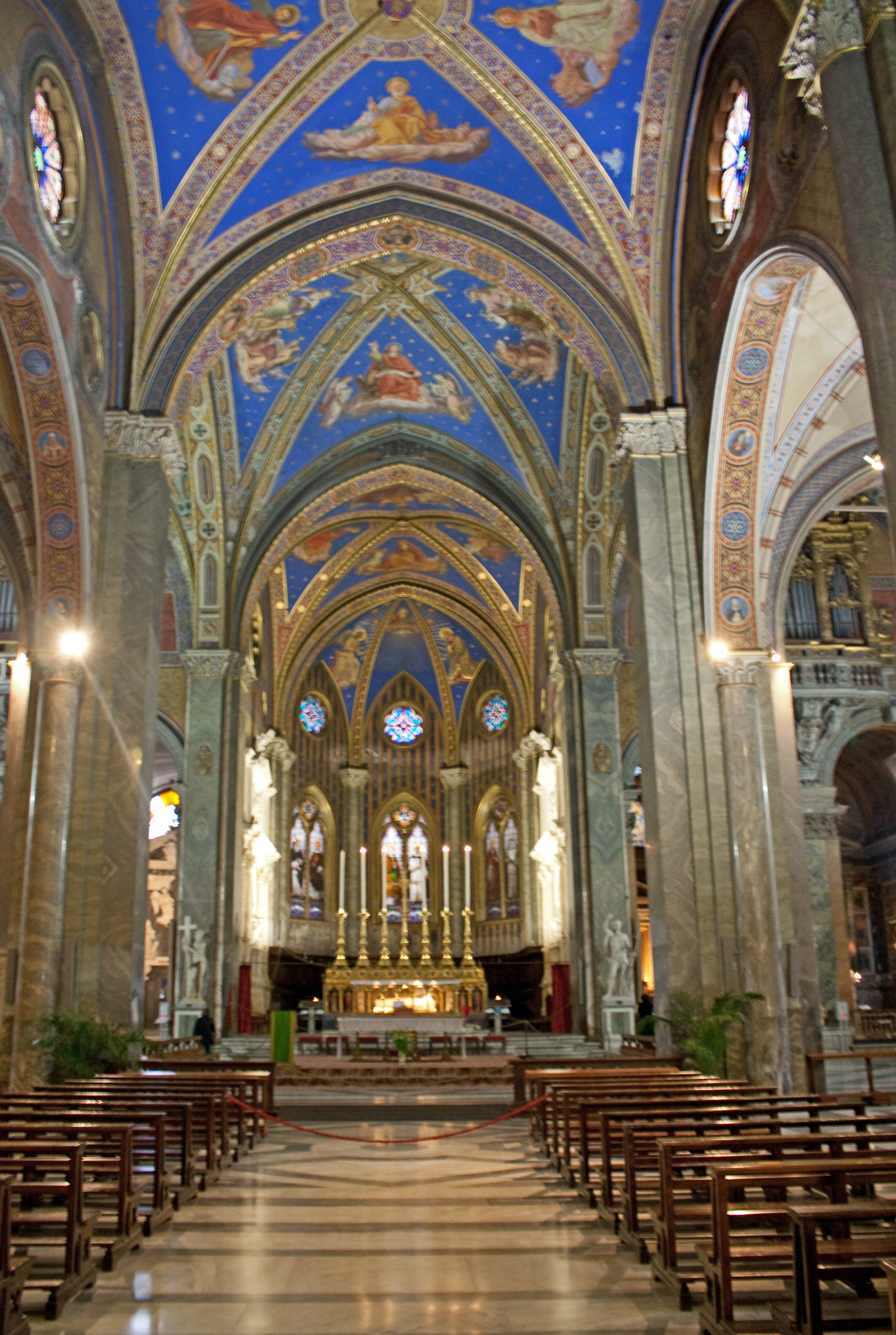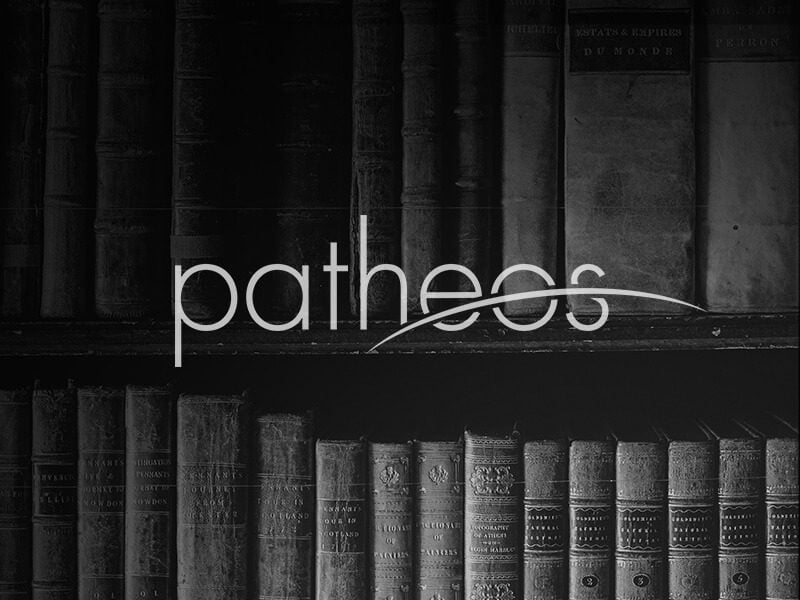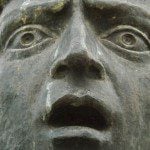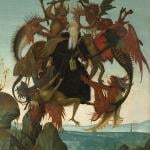Yesterday, I gave some background on the Amazon Synod and the bizarre spectacle of vigilante Catholics throwing a statue called “Our Lady of the Amazon” in the Tiber. You can learn the basic purpose of the synod there. Some, who suckle solely at the teat of Right Wing Lie Machine media, immediately declared that “nobody” calls the figure Our Lady of the Amazon that but me.
Me… and the woman who presented it to the Holy Father:
I stand corrected. I've boosted the audio. This is what is said in Portuguese: "Our Lady of the Amazon." Someone else says "Ave Maria". She continues "the bride of the Church", and then to the other woman "give it to the Church, the Pope" pic.twitter.com/5cAy5c2ogE
— Catholic Sat (@CatholicSat) October 7, 2019
Of which, more next week.
Today, I want to sketch briefly how the Fortress Katolicus vigilantes see the Synod and why they see it that way vs. how the, you know, Church sees it.
Essentially, the vigilantes have, through a years long process of living in an ideological echo chamber, embraced the narrative that evil false pope Bergoglio has, as part of his ongoing effort to corrupt the already apostate Church of Nice into a completely pagan cult, invited a bunch of pagan savages into the Vatican to teach us their pagan ways, worship strange gods, and turn the Church into a liberal PC eco-religion whose highest goods are multi-culturalism and recycling. As I was instructed by one definitely-not-racist reader, Leftists want to offer their children as human sacrifices to climate gods.
In the course of this effort, this fool in the Vatican received a statue representing Pachamama, a fertility goddess, blessed it, and then prostrated the Church in honor of this goddess, and allowed these naked savages into the Church. These human-sacrificing primitives should be dressed like us and knuckling under to the Traditional Latin Mass, not having their own sacred forms for their own sacred ceremonies. Tne Church should not engage in “dialogue” (O hated word!) with these savages. They should instead shut up and let Westerners civilize them and take the bones out of their noses.
So what happened last Monday was simply this (in their eyes): brave and righteous men could stand it no longer and, like Judas Maccabeus, like the Cristeros, like St. Boniface himself! broke into the church where the vile unclean thing was kept and (filming it all the while), stole it, carted it to the Tiber, and hucked it in, cleansing God’s house of idols and sending a clear message from the Real Church to this false church and its godless antipope that the war for Real Catholic Faith is on and the pagan devils and their antichrist servant in a papal mitre will lose.
In short, the vigilantes see themselves defending a Fortress, while the Church trusts that God will defend her as she does what Jesus commands:
Go therefore and make disciples of all nations, baptizing them in the name of the Father and of the Son and of the Holy Spirit, teaching them to observe all that I have commanded you; and behold, I am with you always, to the close of the age.” (Mt 28:19–20).
Indeed, the Reactionaries see themselves as now fighting a desperate rear-guard action to retake the Fortress, which has been overrun with Church of Nice pagans and captured by a heretical false pope. What they seek is vengeance and their response to the desecration of the image was indeed schadenfreude–and immense pride:
Eric Sammons captures the yawp of vigilante triumph over the whole thing:
The spontaneous explosion of joy Catholics around the world are feeling today over the drowning of the Pachamama idol is due to decades of pent-up frustration at our leaders for refusing to stand for Christ and His Church and instead bowing at the altar of Diversity and Dialogue.
— Eric Sammons (@EricRSammons) October 21, 2019
Also characteristic is the assumption that this vigilante act by the tiny minority of Catholics who prefer the EF to the OF is the consensus of all the faithful:
Seen on Facebook: pic.twitter.com/OckS5PZ13t
— Eric Sammons (@EricRSammons) October 21, 2019
This is, of course, achieved by defining themselves as the only Real Catholics and assuming the rest of the Church’s members are false Catholics and pagans. It’s the same way the know that “nobody” (who matters) called the statue Our Lady of the Amazon (except the people who humbly offered it to the Church when they presented it to the Pope for his blessing).
All this brings us to a problem that is literally as old as the Church: the inability of a minority of cultural imperialists to tell the difference between apostolic Tradition and their cultural preferences.
The first time we see this is in the pages of Scripture itself. The Mother Church in Jerusalem, composed of 100% ethnic Jews, reached a premature conclusion about how people joined the Church. As the Church started to attract Gentile pagans, the ancient equivalent of a bunch of St. Blog’s self-appointed internet combox bishops started handing down edicts to these fragile new Gentile believers up in Antioch: “Unless you are circumcised according to the custom of Moses, you cannot be saved.” (Ac 15:1). Circumcision is, here, a shorthand for all the ceremonial laws of the Old Testament. That’s why Paul will also have to argue in his letters that Gentiles also don’t have to keep kosher or observe Jewish feasts and so forth. Essentially the claim was that in order for Gentiles to become Christians they had first to become Jews.
The Judaizers made exactly the same argument as Traditionalist Catholics do against other Catholic developments of doctrine: We’ve always done it this way, so you are innovators and heretics if you change it.
The Council of Jerusalem, meanwhile, was guided by the Spirit to see the real inscape of the ceremonial law and realize that Jesus had altered the paradigm. In a word, it realized that the ceremonial laws were signs pointing to Jesus, the fulfillment of the law. Circumcision did not save, Jesus does. Food does not defile, sin does. Clothes don’t matter, being clothed by Christ does. And so the Church was saved from the folly of imprisoning the gospel in the cultural forms of Judaism and able to welcome Gentiles with their own cultural forms, filling them with Christian content.
This is how pagan temples dedicated to pagan gods could be re-dedicated as Christian Churches such as Santa Maria Sopra Minerva (Saint Mary over Minerva, a shrine dedicated to Mary that used to be shrine dedicated to Minerva):

It’s why there are five pagan sibyls (such as the oracle at Delphi) alternating with seven Jewish prophets on the ceiling of the Sistine Chapel:

The Church’s point is that all truth is God’s truth and so truths spoken by pagans remain true. There is not pagan truth and Christian truth. There is just truth. That’s why Thomas could study Aristotle with profit and the Fathers of the Church could make use of Plato and other Greek philosophers. Indeed, Justin Martyr will actually argue that pagans like Socrates were illuminated by the Holy Spirit:
We have been taught that Christ is the first-born of God, and we have declared above that He is the Word of whom every race of men were partakers; and those who lived reasonably are Christians, even though they have been thought atheists; as, among the Greeks, Socrates and Heraclitus, and men like them.
In short, since Jesus is the Truth, anybody anywhere seeking Truth is seeking Jesus, pagans included. So every indigenous culture outside of Israel can be approached on the basis of those truths and beauties and good things that they love since all these things come from God. The Church need not impose on these cultures some culture alien to it in order for them to be Catholic. Indeed, given that Catholic literally means “universal”, the Tradition obliges us to celebrate the myriad ways in which the one Faith is expressed.
The problem is that the Church must pass between Scylla and Charybdis to do it. She must maintain a careful balance and there are always the ignorant and fanatical pulling on the Church in a multiplicity of directions over their pet obsession. As G.K. Chesterton says:
The Church could not afford to swerve a hair’s breadth on some things if she was to continue her great and daring experiment of the irregular equilibrium. Once let one idea become less powerful and some other idea would become too powerful. It was no flock of sheep the Christian shepherd was leading, but a herd of bulls and tigers, of terrible ideals and devouring doctrines, each one of them strong enough to turn to a false religion and lay waste the world. Remember that the Church went in specifically for dangerous ideas; she was a lion tamer. The idea of birth through a Holy Spirit, of the death of a divine being, of the forgiveness of sins, or the fulfilment of prophecies, are ideas which, any one can see, need but a touch to turn them into something blasphemous or ferocious. The smallest link was let drop by the artificers of the Mediterranean, and the lion of ancestral pessimism burst his chain in the forgotten forests of the north. Of these theological equalisations I have to speak afterwards. Here it is enough to notice that if some small mistake were made in doctrine, huge blunders might be made in human happiness. A sentence phrased wrong about the nature of symbolism would have broken all the best statues in Europe. A slip in the definitions might stop all the dances; might wither all the Christmas trees or break all the Easter eggs. Doctrines had to be defined within strict limits, even in order that man might enjoy general human liberties. The Church had to be careful, if only that the world might be careless.
This is the thrilling romance of Orthodoxy. People have fallen into a foolish habit of speaking of orthodoxy as something heavy, humdrum, and safe. There never was anything so perilous or so exciting as orthodoxy. It was sanity: and to be sane is more dramatic than to be mad. It was the equilibrium of a man behind madly rushing horses, seeming to stoop this way and to sway that, yet in every attitude having the grace of statuary and the accuracy of arithmetic. The Church in its early days went fierce and fast with any warhorse; yet it is utterly unhistoric to say that she merely went mad along one idea, like a vulgar fanaticism. She swerved to left and right, so exactly as to avoid enormous obstacles. She left on one hand the huge bulk of Arianism, buttressed by all the worldly powers to make Christianity too worldly. The next instant she was swerving to avoid an orientalism, which would have made it too unworldly. The orthodox Church never took the tame course or accepted the conventions; the orthodox Church was never respectable. It would have been easier to have accepted the earthly power of the Arians. It would have been easy, in the Calvinistic seventeenth century, to fall into the bottomless pit of predestination. It is easy to be a madman: it is easy to be a heretic. It is always easy to let the age have its head; the difficult thing is to keep one’s own. It is always easy to be a modernist; as it is easy to be a snob. To have fallen into any of those open traps of error and exaggeration which fashion after fashion and sect after sect set along the historic path of Christendom–that would indeed have been simple. It is always simple to fall; there are an infinity of angles at which one falls, only one at which one stands. To have fallen into any one of the fads from Gnosticism to Christian Science would indeed have been obvious and tame. But to have avoided them all has been one whirling adventure; and in my vision the heavenly chariot flies thundering through the ages, the dull heresies sprawling and prostrate, the wild truth reeling but erect.
So one of the most important functions of the Church’s Magisterium has been to use its prudential judgment (and sometimes its dogmatic authority) to help navigate the complex question of where the tradition ends and mere human customs and culture begin. In Acts 15 the resolution to the question of whether Gentiles had to adopt Jewish culture to be saved was articulated by our first Pope, a Jewish Christian speaking to a roomful of Jewish Christians:
“God who knows the heart bore witness to them, giving them the Holy Spirit just as he did to us; and he made no distinction between us and them, but cleansed their hearts by faith. Now therefore why do you make trial of God by putting a yoke upon the neck of the disciples which neither our fathers nor we have been able to bear? But we believe that we shall be saved through the grace of the Lord Jesus, just as they will.” (Ac 15:8–11).
The problem is that the Church then has to navigate history and life on the ground via prudential judgments about how to implement a Tradition that is in the world but not of it. And the results are mixed because prudential judgments are not protected by infallibility and nobody but the Blessed Virgin is graced with sinlessness. Peter himself, after articulating the truth that Gentiles did not need to keep the rites of the law, got cold feet at Antioch and had to be reminded by Paul to obey his own teaching:
When Cephas came to Antioch I opposed him to his face, because he stood condemned. For before certain men came from James, he ate with the Gentiles; but when they came he drew back and separated himself, fearing the circumcision party. And with him the rest of the Jews acted insincerely, so that even Barnabas was carried away by their insincerity. But when I saw that they were not straightforward about the truth of the gospel, I said to Cephas before them all, “If you, though a Jew, live like a Gentile and not like a Jew, how can you compel the Gentiles to live like Jews?” We ourselves, who are Jews by birth and not Gentile sinners, yet who know that a man is not justified by works of the law* but through faith in Jesus Christ, even we have believed in Christ Jesus, in order to be justified by faith in Christ, and not by works of the law, because by works of the law shall no flesh be justified. (Ga 2:11–16)
This pattern plays out repeatedly in the Church’s life. The Church in council and in union with Peter is led by the Spirit to articulate a profound truth at the Jerusalem Synod. Then they all go home and, no longer protected by the charism that guided the council, stumble-bum their way through implementing it on the ground. For infallibility is not impeccability and Peter was specially chosen by Jesus to illustrate that. It’s why he can also whipsaw between these two extremes:
He said to them, “But who do you say that I am?” Simon Peter replied, “You are the Christ, the Son of the living God.” And Jesus answered him, “Blessed are you, Simon Bar-Jona! For flesh and blood has not revealed this to you, but my Father who is in heaven. And I tell you, you are Peter, and on this rock I will build my Church, and the gates of Hades shall not prevail against it. I will give you the keys of the kingdom of heaven, and whatever you bind on earth shall be bound in heaven, and whatever you loose on earth shall be loosed in heaven.” Then he strictly charged the disciples to tell no one that he was the Christ.
From that time Jesus began to show his disciples that he must go to Jerusalem and suffer many things from the elders and chief priests and scribes, and be killed, and on the third day be raised. And Peter took him and began to rebuke him, saying, “God forbid, Lord! This shall never happen to you.” But he turned and said to Peter, “Get behind me, Satan! You are a hindrance to me; for you are not on the side of God, but of men.” (Mt 16:15–23).
So Chesterton remarks that the weakness of Peter is a feature, not a bug, of the papacy:
“When Christ at a symbolic moment was establishing His great society, He chose for its cornerstone neither the brilliant Paul nor the mystic John, but a shuffler, a snob, a coward – in a word, a man. And upon this rock He has built His Church, and the gates of Hell have not prevailed against it. All the empires and the kingdoms have failed, because of this inherent and continual weakness, that they were founded by strong men and upon strong men. But this one thing, the historic Christian Church, was founded on a weak man, and for that reason it is indestructible. For no chain is stronger than its weakest link.”
Accordingly, sometimes the Church succeeds very well in respecting the indigenous culture and adapting it to the Tradition so that people can keep their sacred trees at Christmas or use grandma’s wedding ring. As St. John Henry Newman tells us:
“The use of temples, and these dedicated to particular saints, and ornamented on occasions with branches of trees; incense, lamps, and candles; votive offerings on recovery from illness; holy water; asylums; holydays and seasons, use of calendars, processions, blessings on the fields; sacerdotal vestments, the tonsure, the ring in marriage, turning to the East, images at a later date, perhaps the ecclesiastical chant, and the Kyrie Eleison are all of pagan origin, and sanctified by their adoption into the Church.”
Other times, as for example, when Jesuit missionaries tried evangelize China by adopting Chinese dress and adapting Chinese ancestor veneration to the gospel, the Church’s leaders have made spectacularly bad calls and suppressed such strategies for centuries (till Rome, in the mid-20th century said, “Oops.”). How did such a blunder occur? It occurred because Rome was in the maelstrom of the Reformation and was battening down the hatches in fear of all innovation. In short, it recapitulated the blunder of Peter at Antioch and listened, not to its own Tradition but to mere arch-conservative cultural voices saying, “The Jesuits are going native. To be Catholic means to be Western. There can be no Catholic Church in Chinese dress. It has to look European.”
Some will object that this is the Church co-opting paganism. The thing is, it’s important to remember that the last thing the ancient pagans did was become Christian. In other words, former pagans “appropriated” their own cultural and religious forms and re-purposed them for their new faith. It’s not like some bureaucrat decreed that Easter eggs were no longer Germanic fertility symbols and were now symbols of the Empty Tomb. It’s that new Christians said, “Hey! We’ve always loved decorating eggs, let’s keep doing that at Easter. We can use them as a symbol of the Empty Tomb since that’s about as big a connection to New Life as you can get!” It was a fruit of the conversation between Christian missionaries and the people they were evangelizing who liked each other.
Exactly the same thing happened in South America with many missionaries. Which brings us to the dreaded Pachamama, the fertility deity worshipped by Amazonian Basin Andean peoples.
That right, voracious Church Militant reader: According to Ines San Martin, an Argentine journalist covering the Vatican who is Rome bureau chief and co-editor of Crux:
“Traditionalist Catholics claim the statue is a representation of the Pachamama, a pagan symbol of mother earth. However, the Pachamama is not featured in Amazonian indigenous populations, as it’s a goddess revered by the Incas, the indigenous people of the Andes.”
Yes, incredibly, the most consistently wrong-about-everything subculture in the Church was dead wrong when, through a process of graduating from Google University in ten seconds and echo chamber reinforcement from relying on Right Wing Media and word of mouth, they authoritatively quoted each other confidently declaring that Amazonian pagans worship “Pachamama”. They don’t.
This is why conservative enemies of the Pope should, at long last, listen to the Church, especially when Abp. Charles Chaput warned you four years ago that these unreliable news sources you still insist on trusting are unreliable:
The Lepanto Institute and Church Militant have proven once again that they are not interested in presenting information in any useful way. Neither the World Meeting of Families-Philadelphia 2015 nor any of its leadership supports Planned Parenthood. The sole desire of both Lepanto and Church Militant is to create division, confusion, and conflict within the Church. Actions of that nature run contrary to Christian tradition. Their reports are not to be taken seriously.
So the insta-experts in Amazonian spirituality who ginned up hysteria on-line had no idea what they were talking about (again). But the more interesting point is that a bunch of liberal modernist Vatican 2 boomer FrancisChurch missionaries did let South American indigenous people have their Pachamama images.
400 years ago:
Catholic History 101
-Notre Dame was built over a temple to Jupiter-S. Maria Sopra Minerva in Rome Xtianized a pagan temple
-Spanish missionaries to S.Amer used mountain image of #Pachamama w/face of BVM ~400 yrs ago#WeAreCristeros is iconoclasm, not Catholic @StefMNicholas pic.twitter.com/bwSGQIhUMm
— Fr Joseph Simmons, SJ (@PepeAMDG) October 22, 2019
That’s right. Four centuries ago the people who *did* worship Pachamama were approached by the time-honored Catholic method of repurposing sacred images already familiar and comfortable to them as Christian images with an entirely new meaning.
Which brings us, next time, to the shameful spectacle in Rome this past Monday. Of which more on Monday.











